Overview
- Description
- Photocopy of Terezin diary written in German by unknown woman and 2 page description of a transport to Theresienstadt.
- Credit Line
- United States Holocaust Memorial Museum Collection, Gift of Michael Gruenbaum
Physical Details
- Genre/Form
- Diary.
- Extent
-
1 folder
Rights & Restrictions
- Conditions on Access
- There are no known restrictions on access to this material.
- Conditions on Use
- Material(s) in this collection may be protected by copyright and/or related rights. You do not require further permission from the Museum to use this material. The user is solely responsible for making a determination as to if and how the material may be used.
Keywords & Subjects
- Corporate Name
- Theresienstadt (Concentration camp)
Administrative Notes
- Holder of Originals
-
United States Holocaust Memorial Museum
- Legal Status
- Permanent Collection
- Provenance
- Donated to the United States Holocaust Memorial Museum in 2018 by Michael Gruenbaum.
- Record last modified:
- 2024-03-20 13:52:14
- This page:
- https://collections.ushmm.org/search/catalog/irn634846
Download & Licensing
- In Copyright - Use Permitted
- Terms of Use
- This record is not digitized and cannot be downloaded online.
In-Person Research
- Request 7 Days in Advance of Visit
- Plan a Research Visit
-
Request in Shapell Center Reading Room
Bowie, MD
Contact Us
Also in Margaret Gruenbaum family collection
The collection consists of six handcrafted metal artifacts, documents, a memory book, and a scrapbook album related to the experiences of Margaret Gruenbaum and her children, Marietta and Michael, in Czechoslovakia before and during the Holocaust. The collection also includes a photocopy of a Terezin diary written in German by an unknown woman and a two-page description of a transport to Theresienstadt. Some of these materials may be combined into a single collection in the future.
Date: approximately 1940-approximately 1945

Horse-shaped metal pin made by a Jewish prisoner in Theresienstadt ghetto-labor camp
Object
Pin given to Margarete Grünbaum (later Margaret Gruenbaum) in Theresienstadt ghetto-labor camp by a fellow inmate who worked with her in the camp’s Arts Department between November 1942 and May 1945. Before Czechoslovakia was occupied by Germany in 1939, Margarete lived in Prague with her husband, Karel, and their children, Marietta and Michael. In October 1941, Karel was arrested by the Gestapo and detained in Pankrác prison in Prague. On December 3, Karel was sent to Theresienstadt ghetto-labor camp, where he was killed on the 18th in the Small Fortress. On November 20, 1942, Margarete, Michael, and Marietta were sent to the ghetto-labor camp aboard transport Cc. Margarete was sent to work in the art studio where she made artificial flowers, teddy bears, and stage sets for theater productions. When the family received orders for deportation to Auschwitz killing center in German-occupied Poland in the fall of 1944, Margarete’s job in the workshop saved her family. She asked her boss, the Dutch artist, Josef Spier, to help her convince the German camp guard in charge of the department that her work, creating teddy bears and others toys for Germans for the Christmas season, was important enough to keep her and her children in Terezín. The guard wanted toys for his family, so he removed them from the transport list and they remained at Theresienstadt. They were liberated from the camp on May 8, 1945, by the Soviet Army.
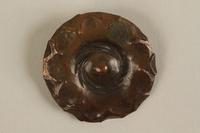
Metal flower pin made by a Jewish prisoner in Theresienstadt ghetto-labor camp
Object
Pin given to Margarete Grünbaum (later Margaret Gruenbaum) in Theresienstadt ghetto-labor camp by a fellow inmate who worked with her in the camp’s Arts Department between November 1942 and May 1945. Before Czechoslovakia was occupied by Germany in 1939, Margarete lived in Prague with her husband, Karel, and their children, Marietta and Michael. In October 1941, Karel was arrested by the Gestapo and detained in Pankrác prison in Prague. On December 3, Karel was sent to Theresienstadt ghetto-labor camp, where he was killed on the 18th in the Small Fortress. On November 20, 1942, Margarete, Michael, and Marietta were sent to the ghetto-labor camp aboard transport Cc. Margarete was sent to work in the art studio where she made artificial flowers, teddy bears, and stage sets for theater productions. When the family received orders for deportation to Auschwitz killing center in German-occupied Poland in the fall of 1944, Margarete’s job in the workshop saved her family. She asked her boss, the Dutch artist, Josef Spier, to help her convince the German camp guard in charge of the department that her work, creating teddy bears and others toys for Germans for the Christmas season, was important enough to keep her and her children in Terezín. The guard wanted toys for his family, so he removed them from the transport list and they remained at Theresienstadt. They were liberated from the camp on May 8, 1945, by the Soviet Army.
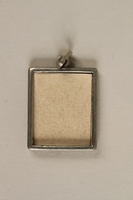
Miniature picture frame pendant made by a Jewish prisoner in Theresienstadt ghetto-labor camp
Object
Pendant given to Margarete Grünbaum (later Margaret Gruenbaum) in Theresienstadt ghetto-labor camp by a fellow inmate who worked with her in the camp’s Arts Department between November 1942 and May 1945. Before Czechoslovakia was occupied by Germany in 1939, Margarete lived in Prague with her husband, Karel, and their children, Marietta and Michael. In October 1941, Karel was arrested by the Gestapo and detained in Pankrác prison in Prague. On December 3, Karel was sent to Theresienstadt ghetto-labor camp, where he was killed on the 18th in the Small Fortress. On November 20, 1942, Margarete, Michael, and Marietta were sent to the ghetto-labor camp aboard transport Cc. Margarete was sent to work in the art studio where she made artificial flowers, teddy bears, and stage sets for theater productions. When the family received orders for deportation to Auschwitz killing center in German-occupied Poland in the fall of 1944, Margarete’s job in the workshop saved her family. She asked her boss, the Dutch artist, Josef Spier, to help her convince the German camp guard in charge of the department that her work, creating teddy bears and others toys for Germans for the Christmas season, was important enough to keep her and her children in Terezín. The guard wanted toys for his family, so he removed them from the transport list and they remained at Theresienstadt. They were liberated from the camp on May 8, 1945, by the Soviet Army.
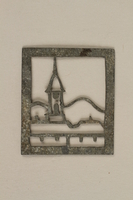
Cut-out landscape scene made by a Jewish prisoner in Theresienstadt ghetto-labor camp
Object
Miniature metalwork given to Margarete Grünbaum (later Margaret Gruenbaum) in Theresienstadt ghetto-labor camp by a fellow inmate who worked with her in the camp’s Arts Department between November 1942 and May 1945. Before Czechoslovakia was occupied by Germany in 1939, Margarete lived in Prague with her husband, Karel, and their children, Marietta and Michael. In October 1941, Karel was arrested by the Gestapo and detained in Pankrác prison in Prague. On December 3, Karel was sent to Theresienstadt ghetto-labor camp, where he was killed on the 18th in the Small Fortress. On November 20, 1942, Margarete, Michael, and Marietta were sent to the ghetto-labor camp aboard transport Cc. Margarete was sent to work in the art studio where she made artificial flowers, teddy bears, and stage sets for theater productions. When the family received orders for deportation to Auschwitz killing center in German-occupied Poland in the fall of 1944, Margarete’s job in the workshop saved her family. She asked her boss, the Dutch artist, Josef Spier, to help her convince the German camp guard in charge of the department that her work, creating teddy bears and others toys for Germans for the Christmas season, was important enough to keep her and her children in Terezín. The guard wanted toys for his family, so he removed them from the transport list and they remained at Theresienstadt. They were liberated from the camp on May 8, 1945, by the Soviet Army.
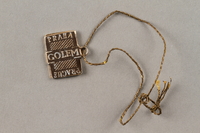
Golem pendant made by a Jewish prisoner in Theresienstadt ghetto-labor camp
Object
Pendant given to Margarete Grünbaum (later Margaret Gruenbaum) in Theresienstadt ghetto-labor camp by a fellow inmate who worked with her in the camp’s Arts Department between November 1942 and May 1945. Before Czechoslovakia was occupied by Germany in 1939, Margarete lived in Prague with her husband, Karel, and their children, Marietta and Michael. In October 1941, Karel was arrested by the Gestapo and detained in Pankrác prison in Prague. On December 3, Karel was sent to Theresienstadt ghetto-labor camp, where he was killed on the 18th in the Small Fortress. On November 20, 1942, Margarete, Michael, and Marietta were sent to the ghetto-labor camp aboard transport Cc. Margarete was sent to work in the art studio where she made artificial flowers, teddy bears, and stage sets for theater productions. When the family received orders for deportation to Auschwitz killing center in German-occupied Poland in the fall of 1944, Margarete’s job in the workshop saved her family. She asked her boss, the Dutch artist, Josef Spier, to help her convince the German camp guard in charge of the department that her work, creating teddy bears and others toys for Germans for the Christmas season, was important enough to keep her and her children in Terezín. The guard wanted toys for his family, so he removed them from the transport list and they remained at Theresienstadt. They were liberated from the camp on May 8, 1945, by the Soviet Army.
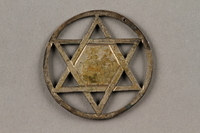
Round Star of David pendant made by a Jewish prisoner in Theresienstadt ghetto-labor camp
Object
Pendant given to Margarete Grünbaum (later Margaret Gruenbaum) in Theresienstadt ghetto-labor camp by a fellow inmate who worked with her in the camp’s Arts Department between November 1942 and May 1945. Before Czechoslovakia was occupied by Germany in 1939, Margarete lived in Prague with her husband, Karel, and their children, Marietta and Michael. In October 1941, Karel was arrested by the Gestapo and detained in Pankrác prison in Prague. On December 3, Karel was sent to Theresienstadt ghetto-labor camp, where he was killed on the 18th in the Small Fortress. On November 20, 1942, Margarete, Michael, and Marietta were sent to the ghetto-labor camp aboard transport Cc. Margarete was sent to work in the art studio where she made artificial flowers, teddy bears, and stage sets for theater productions. When the family received orders for deportation to Auschwitz killing center in German-occupied Poland in the fall of 1944, Margarete’s job in the workshop saved her family. She asked her boss, the Dutch artist, Josef Spier, to help her convince the German camp guard in charge of the department that her work, creating teddy bears and others toys for Germans for the Christmas season, was important enough to keep her and her children in Terezín. The guard wanted toys for his family, so he removed them from the transport list and they remained at Theresienstadt. They were liberated from the camp on May 8, 1945, by the Soviet Army.
Michael Gruenbaum collection
Document
Collection consists of a large scrapbook with a burlap cover, small memory book, and several documents. Consists of one album created by Margaret Gruenbaum, mother of the donor, while imprisoned in Terezin. Includes cloth badges, receipts, notifications, flyers, stamps, artwork and other documents collected in wartime Terezin. Also includes one memory book, entitled "Pamatnik" created by Michael Gruenbaum and friends while living in Room 7, Building L 417 in Terezin. Includes translations of the memory book, of poetry written by Michael and the other children, and loose documents from Terezin.



